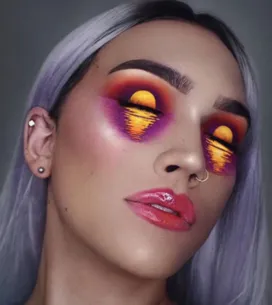Hair colourist Ursula Goff has been turning tresses into colourful masterpieces inspired by works of fine art, and we have to say they look freaking incredible. For anyone who thought the works of Boticelli could never been interpreted into a hairstyle, think again my friends, cos here's the proof...
Not only does Ursula have an amazing knack for turning her own and her clients hair into colourful works of art, she also clearly has a love for art, and each dye job in her 'Fine Art' series is done with a great deal of thought and detail. Just check out what she had to say about her hair-related impression of Van Gogh's 'Starry Night':
I am sharing Van Gogh's "Starry Night" again for those who missed it, and also because I didn't originally publish any background on it. This is only one piece of a rather large body of work completed the last two years of Van Gogh's life, and Van Gogh himself was not impressed with it, never having any inkling that it would go on to become one of the most recognised pieces of art in Western history.
He began it shortly after being admitted to the St. Rémy de Provence asylum, and it's largely composed of the view from his room, with the addition of a fictional village. Earlier in life, he had been very religious and had set out to become a pastor, but could never pass his exams and he struggled with his mental health continuously. He later abandoned religion, but still seemed to be searching for meaning and purpose, speculating that "hope is in the stars" - referencing the desire to experience an afterlife, perhaps in the stars or in another dimension.
This desire stemmed from the fact that he had never been particularly happy, and suffered from depression, hallucinations, delusions, psychotic breaks, and a general inability to function, often trying to live and work on his own, but always failing, which would result in admittance to an asylum or going back to live with family or friends. He ultimately took his own life at age 37, dying from a self-inflicted gunshot wound that became infected.
It could be argued that Van Gogh's mental illness fueled his creativity and made him a great artist, but even if that's true, his story is heartbreaking. It's hard for me to gauge if his enormous contributions to art were worth all the suffering this poor man endured. It's commonly believed, however, that suffering and art go hand in hand."
Fine Art Series: I am sharing Van Gogh's "Starry Night" again for those who missed it, and also because I didn't originally publish any background on it. This is only one piece of a rather large body of work completed the last two years of Van Gogh's life, and Van Gogh himself was not impressed with it, never having any inkling that it would go on to become one of the most recognized pieces of art in Western history. He began it shortly after being admitted to the St. Rémy de Provence asylum, and it's largely composed of the view from his room, with the addition of a fictional village. Earlier in life, he had been very religious and had set out to become a pastor, but could never pass his exams and he struggled with his mental health continuously. He later abandoned religion, but still seemed to be searching for meaning and purpose, speculating that "hope is in the stars" - referencing the desire to experience an afterlife, perhaps in the stars or in another dimension. This desire stemmed from the fact that he had never been particularly happy, and suffered from depression, hallucinations, delusions, psychotic breaks, and a general inability to function, often trying to live and work on his own, but always failing, which would result in admittance to an asylum or going back to live with family or friends. He ultimately took his own life at age 37, dying from a self-inflicted gunshot wound that became infected. It could be argued that Van Gogh's mental illness fueled his creativity and made him a great artist, but even if that's true, his story is heartbreaking. It's hard for me to gauge if his enormous contributions to art were worth all the suffering this poor man endured. It's commonly believed, however, that suffering and art go hand in hand. What do you think? #art #fineart #vangogh #starrynight #starrynighthair #bluehair #yellowhair #postimpressionism #modernsalon #behindthechair
A photo posted by Ursula Goff (@uggoff) on Jan 30, 2016 at 8:11am PST
WOW, right?! For anyone with an eye for art (or just a love of really, really nice dyed hair), check out our favourites in Ursula's incredible range:
Drowning Girl, and Pop Art Newsweek cover, by Roy Lichtenstein
Fine Art Series: Drowning Girl, and Pop Art Newsweek cover, by Roy Lichtenstein. Lichtenstein was a pop artist in the 60's, most well known for his not-quite-exact copies of actual comic book panels. There is still debate in the art world as to whether his work can be considered original, or if it's flat out plagiarism. Some insist that such "borrowing" would never fly in any other genre, especially music; that permission and credit must always be given in order to use someone's work. Further, Lichtenstein made enormous sums of money off of these works, while the original artists were often not paid well at all, and many regularly experienced financial hardships. Others say that Lichtenstein took what was considered "low art" at the time, and elevated it to fine art status, immortalizing work that many people would normally never see or appreciate. In fact, the comics industry at the time rarely gave artistic credit to its illustrators, and many comic artists even voluntarily declined having their name attached to their work, likely due to the stigma that it wasn't "real" art. There may even be merit to the argument that without Lichtenstein's work, the comic industry may never have evolved into its current massive (and appreciated) status. However, I think that could have happened even if Lichtenstein had given the original artists credit. What do you guys think - was Lichetenstein doing the comics industry enough of a favor that he didn't owe them any compensation or credit? Or should credit always be given regardless of the outcome? #art #fineart #popart #lichtenstein #comics #bluehair #specialeffects #modernsalon #behindthechair #fashionablygeek
A photo posted by Ursula Goff (@uggoff) on Jan 29, 2016 at 10:48am PST
Red Canna Lily, by Georgia O'Keeffe
Fine Art Series: Red Canna Lily, by Georgia O'Keeffe, who may be the female artist most people are familiar with. This painting is in the style she is most well known for: large close-ups of individual flowers. However, O'Keeffe herself didn't appreciate the interpretations given these works - most attributed Freudian theories (popular at the time), which of course meant that many assumed these to be representations of female genitalia. Second wave feminists even went so far as to consider O'Keeffe a pioneer of "female iconography", but O'Keefe continued to insist that she had simply painted flowers, and refused to work with feminist groups on any projects, feeling as though her own ideas had been co-opted by other agendas. This encouraged a change in subject matter for her, although she still painted in a characteristic style, using oils but conveying a soft, blended feel more reminiscent of water colors. This change did not harm her career, and she continued to be held in high regard and acquired a moderate amount of fame throughout the course of her life. I think her story brings forth interesting questions about the relationship between art and the viewer: does the artist alone get to control what their art is about? Or does the audience get to have a say? Do we have to accept outside interpretations for art, even if the artist disagrees with them? Is it fair to tell an artist what they may be "subconsciously" conveying? This is one of the fears of putting oneself out there artistically: that you will be misunderstood, misrepresented, and perhaps even rejected - understood or otherwise. O'Keeffe's situation, then, clearly demonstrates the vulnerability of being an artist. #art #painting #okeefe #georgiaokeeffe #redcanna #lilies #fineart #vulnerability #redhair #orangehair #yellowhair #flowers #modernsalon #behindthechair #fashionablygeek @nikkdawgg
A photo posted by Ursula Goff (@uggoff) on Jan 27, 2016 at 10:12am PST
Claude Monet
Fine Art Series: This is one of many water lilies paintings that Claude Monet painted. Monet is the most famous of the Impressionist artists, who sought to focus on light and movement, often at the expense of form. Initially not well received, the term "Impressionism" was borrowed from a derogatory review by an art critic. However, it ultimately created the inertia that moved art into the modern period, freeing up a multitude of future artists to use freer and looser styles. Monet himself, however, struggled to internalize the influence of his work, battling depression and feelings of failure his entire life, destroying as many as 500 hundred of his own paintings, and even attempting suicide at one point. This goes to illustrate that no matter our feelings about ourselves, we can still have an enormous ongoing influence in the world; perhaps in that sense, there is no such thing as failure. #art #painting #Impressionism #Monet #impressionists #bluehair #greenhair #minthair #behindthechair #modernsalon
A photo posted by Ursula Goff (@uggoff) on Jan 26, 2016 at 7:14pm PST
The Kiss, by Austrian Symbolist Gustav Klimt
Fine Art series: The Kiss, by Austrian Symbolist Gustav Klimt. Perhaps one of my favorite paintings, this work is characteristic of Klimt's gold period, where he did many paintings adorned with gold leaf and warm tones. Klimt's artistic career is a great example of failure being followed by immense success. More than a decade before this painting was done, Klimt received a serious blow to his artistic reputation. He had been commissioned to make three paintings for the University of Vienna. He spent several years on them, but they were not only rejected by the university, but also very heavily criticized for being "pornographic". (Check them out to see for yourself - they are titled "Philosophy", "Medicine", and "Jurisprudence", and were ultimately destroyed by Nazis during WWII. I happen to think they are quite beautiful, and visually interesting, and think it is shameful they were rejected.) Soon after, Klimt spent some time in Italy, which exposed him to Byzantine mosaics that likely heavily influenced his use of gold leaf in future works. This style is what ultimately gave him critical praise which then allowed him to become highly selective about the commissions he took, leading to a very financially comfortable life. His work now fetches some of the highest prices in the art world. I like this story because it highlights that success is often a long road, occasionally punctuated by enormous failure or loss. If you are looking to achieve anything, on any level, then it seems that the absolute best strategy is to simply persist. Keep going. Keep trying. Do you agree? When you look back on your life, do you feel that your failures were necessary stops on the way? #art #painting #klimt #gustavklimt #thekiss #gold #goldleaf #yellowhair #goldhair #symbolism #failure #success #behindthechair #modernsalon #fashionablygeek
A photo posted by Ursula Goff (@uggoff) on Jan 25, 2016 at 12:44pm PST
Birth of Venus, by Boticelli
Fine Art Series: This is the famous "Birth of Venus", by Boticelli. This painting is enormous - 6 by 9 feet - and has some interesting history behind it. First off, it was painted in the early Renaissance period (1480's), and it's one of the first serious works ever done on canvas (in tempera, which is egg based paint), as wood panels had been the preferred surface before. More interestingly, it also depicts a fully nude woman who is NOT affiliated with Christianity, which was considered somewhat scandalous at the time. This was probably a reflection of the growing interest in humanism and the re-emergence of mythology in art at the time. However, Boticelli himself is said to have had a nervous breakdown due to his guilt in painting "pagan" works after a fanatical friar briefly gained power in Florence, Italy. The friar, named Savanarola, criticized and condemned "vanity" items like jewelry, books, mirrors, and frivolous art, and even had an event called "The Burning of the Vanities", where an enormous pile of such items was set on fire in the town square! How Boticelli's painting escaped its demise in this event is not known, but his work took a decidedly more spiritual, Christian turn afterwards. This brings to mind questions about censorship - what do you guys think? Should some art be censored? Is some art inappropriate? If so, who gets to decide, and what should be done with inappropriate art? How does this incident compare with more recent censorship situations? @sadiehutch2013 #art #Boticelli #venus #birthofvenus #greekmyths #greekmythology #renaissance #painting #tempera #bluehair #rainbowhair #unicornhair #mermaidhair #behindthechair #modernsalon
A photo posted by Ursula Goff (@uggoff) on Jan 23, 2016 at 11:25am PST
Marilyn Monroe, by Andy Warhol
Fine Art Series: Andy Warhol may be the most iconic artist of the 20th century. He was fascinated with fame and Hollywood, and is most well known for his silk screen portraits of celebrities, although he also dabbled in other mediums, like film and music, and wrote two books and had his own magazine. His numerous renditions of Marilyn Monroe in various combinations of bright colors may be almost as famous as Marilyn herself, and his background as an illustrator shows in his "as-is" style, where he did not correct smudges or mistakes in his prints, believing that mistakes could be better than perfection. He was sometimes accused of being superficial in his art, but likely didn't mind such a designation, even admitting at one point that he loved how "plastic" Hollywood is, and that he even wished to be plastic himself. He blurred the line between art and consumerism, creating much of his art with the help of assistants on a production line, not unlike that of other commodities, and even named his studio "The Factory". What do you guys think - is it art if it's still mass produced and filled with "mistakes"? Or do the mistakes contribute to the uniqueness of each piece enough that they all qualify as "real" art? Is a print of a Campbell's soup can art? Is art defined by the skill or time involved, or by the image itself, or both? These are some of the sorts the questions that Warhol's work generated, and they are still relevant today. #Warhol #popart #marilynmonroe #silkscreen #screenprint #art #artist #pinkhair #yellowhair #specialeffects #behindthechair #modernsalon
A photo posted by Ursula Goff (@uggoff) on Jan 22, 2016 at 10:42am PST
Girl With a Pearl Earring, by Johannes Vermeer
Next in the Fine Art series is Girl With a Pearl Earring, by Dutch painter Johannes Vermeer. What is interesting about this color palette, along with many other Vermeer works, is his almost grandiose use of the blue tone (probably ultramarine), which was unusual at the time for artists, as it was a VERY expensive pigment, and Vermeer was not known to have made a lot of money in his lifetime. This pop of color against the warmer brown tones of the rest of the canvas give the painting a sense of newness, contrasted with the duller tones of most other paintings in the 17th century. It's also an excellent study in light and shadow, which Vermeer had an uncanny ability to recreate (it's been suggested that he may have had some help on that with camera obscuras or similar optics). If you want to see some of the earliest works of photorealism, look into some more of Vermeer's work, particularly "The Art of Painting" and "The Astronomer". #art #painting #vermeer #johannesvermeer #dutch #mermaidhair #unicornhair #rainbowhair #specialeffects #redken #redkenshades #behindthechair #modernsalon @bestcupcakemum
A photo posted by Ursula Goff (@uggoff) on Jan 21, 2016 at 9:10am PST
The Scream, by Edvard Munch
I often get asked where I went to hair school, and what sort of cosmetology education background I have. The answer is probably disappointing for most people - I went to a community college Cosmo program and have almost no other training outside of that. However, I have done art since I was 5, first developing hand skills as a sketcher, and then expanding those skills into color by working with acrylics, tempera, and especially water colors. I tend to color hair much the same way I color a canvas, using the same sorts of color application techniques and identical color theory. So in honor of my art background being so useful, I thought I'd do a Fine Art series, similar in concept to the Starry Night/hair presentation I recently did. Today, I'm sharing the work of Norwegian artist Edvard Munch. His work tends to fall under the Symbolism category, and this is his most well known painting, "The Scream", which has a bit of an unusual color palette, which I think contributes to the emotional discord of the image. I tend to very strongly agree with Munch's art philosophy: "I do not believe in the art which is not the compulsive result of Man's urge to open his heart." Many things I make simply because they are pretty, but my favorite pieces force themselves out of me in surges of emotional energy. Without art, I think I'd be far more dysfunctional, as I would struggle to express myself in other ways. @asset35 #painting #symbolism #edvardmunch #thescream #rainbowhair #mermaidhair #unicornhair #orangehair #bluehair #joico #specialeffects #pravana #behindthechair
A photo posted by Ursula Goff (@uggoff) on Jan 20, 2016 at 8:48am PST
Which is your favourite? Tweet us @sofeminineUK!
You Might Also Like...
Disney Reimagined In The Style Of Tim Burton Is Seriously Disturbing
Ladies, Say Hello To Curvy Barbie
Sansa Stark Is FINALLY Going To Be A Total Badass In Season Six Of Game Of Thrones













